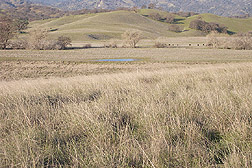Restoring California's Native Grasses |
|
 Deep-rooted California native perennial grasses (foreground) not only stabilize the soil and improve general soil health but also provide a valuable habitat for animals and birds. (K11107-1) |
California's grasslands were once vegetated by native perennial grasses. But during the last 200 years, exotic annual grasses from Europe started taking over, and now only 2 percent of the state's grasslands are vegetated by native perennial grasses. ARS is working with university researchers and environmental groups to study how revegetation affects soil and water quality, invasive weeds, and availability of grazing forage. Plant physiologist Stephen M. Griffith, of the Forage Seed and Cereal Research Unit in Corvallis, Oregon, is leading ARS's efforts in this research. Studying three grass fields 30 miles west of Sacramento, California, Griffith hopes to develop a better understanding of how well revegetation efforts work. One field contains annual grasses, one is a newly restored field of native grasses, and the third has contained native grasses for 10 years. "There are many advantages of the native grasses, whether as forage for animals or as habitat for wildlife," says Griffith. Unlike annual grasses, perennial grasses turn green faster, stay green longer, and produce more biomass. This equates to more protein and higher value forage for both wildlife and livestock. The site that contained annual grass had significantly fewer tons per acre of aboveground plant biomass accumulation than the two plots that were restored to native grasses. Native grasses integrate better with other plants. That diversity of plants attracts wildlife not found in annual grasses. "We've noticed a significant change in biodiversity in the 4 years that ARS has used my farm for research," says California farmer John Anderson. Furthermore, native grasses improve soil and limit erosion. There are about 300 species of native grasses, which began to get displaced when Spaniards settled in California in the mid 1500s, bringing livestock and new land practices. Annual grasses took over in the 1800s, possibly because of overgrazing. ARS is working with Audubon California on restoration projects on farms and ranches. It is difficult to get perennials established because annuals outcompete them. "We're looking at various methods, such as using controlled fires, applying herbicides, and determining what species grow best in which areas of California," Griffith says. He does say that once perennials are established, their deep roots should help them get rid of annual grasses. And ranchers now know the importance of not overgrazing, so there likely won't be a repeat of what happened in the 1800s. One problem is that native-grass seed is very expensive. It may cost $40 a pound, while turfgrass seed is about 50 cents a pound. Griffith hopes that showing the positive effects of native grasslands will influence supply and demand and make native grass more affordable. Collaborators elsewhere are studying whether native grasses have value as forage; which plants—besides grasses—make up a healthy grassland; what kinds of wildlife appear after native grasses are reintroduced; and whether GIS analysis can determine biomass of grasslands.—By David Elstein, Agricultural Research Service Information Staff. This research is part of Rangeland, Pasture, and Forages, an ARS National Program (#205) described on the World Wide Web at www.nps.ars.usda.gov. Stephen M. Griffith is in the USDA-ARS Forage Seed and Cereal Research Unit, 3450 S.W. Campus Way, Corvallis, OR 97331; phone (541) 738-4154, fax (541) 738-4160. "Restoring California's Native Grasses" was published in the May 2004 issue of Agricultural Research magazine.
|






